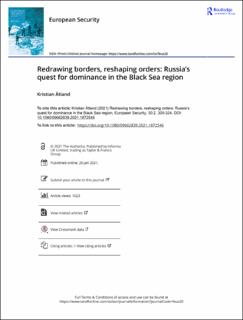| dc.contributor.author | Åtland, Kristian | |
| dc.date.accessioned | 2021-04-28T13:38:10Z | |
| dc.date.available | 2021-04-28T13:38:10Z | |
| dc.date.created | 2021-01-21T09:34:39Z | |
| dc.date.issued | 2021 | |
| dc.identifier.citation | Åtland, K. (2021). Redrawing borders, reshaping orders: Russia’s quest for dominance in the Black Sea region. European Security, 30(2), 305-324. doi: | en_US |
| dc.identifier.issn | 1746-1545 | |
| dc.identifier.uri | https://hdl.handle.net/11250/2740221 | |
| dc.description.abstract | Since Russia’s annexation of Crimea in March 2014, severe limitations have been placed on Ukraine’s coastal state rights and navigational freedoms in the Black and Azov Seas and the Kerch Strait. The "Kerch Strait clash" in November 2018, which resulted in the Russian capture of three Ukrainian naval vessels in international waters south of the strait, can be seen as the temporary culmination of tensions that have been building up over a longer period. In violation of international law and bilateral agreements, Russia has in recent years pursued an increasingly assertive and revisionist policy in the region and sought to turn the maritime spaces on the country’s southwestern flank into a "Russian lake". This policy is affecting not only the security and economy of neighbouring states such as Ukraine and Georgia, but also the strategic balance in the southeastern corner of Europe. Drawing on empirical evidence derived from Russian, Ukrainian and Western sources, as well as insights from neoclassical realist theory, this article discusses legal, economic and security aspects of Russia’s ongoing quest for a dominant position in the Black Sea region. | en_US |
| dc.language.iso | eng | en_US |
| dc.publisher | Routledge (Taylor & Francis group) | en_US |
| dc.relation.uri | https://www.tandfonline.com/doi/full/10.1080/09662839.2021.1872546 | |
| dc.rights | Attribution-NonCommercial-NoDerivatives 4.0 Internasjonal | * |
| dc.rights.uri | http://creativecommons.org/licenses/by-nc-nd/4.0/deed.no | * |
| dc.title | Redrawing borders, reshaping orders : Russia’s quest for dominance in the Black Sea region | en_US |
| dc.type | Peer reviewed | en_US |
| dc.type | Journal article | en_US |
| dc.description.version | publishedVersion | en_US |
| dc.rights.holder | © 2021 The Author(s) | en_US |
| dc.subject.nsi | VDP::Samfunnsvitenskap: 200::Statsvitenskap og organisasjonsteori: 240::Internasjonal politikk: 243 | en_US |
| dc.subject.nsi | VDP::Samfunnsvitenskap: 200 | en_US |
| dc.source.pagenumber | 305-324 | en_US |
| dc.source.volume | 30 | en_US |
| dc.source.journal | European Security | en_US |
| dc.source.issue | 2 | en_US |
| dc.identifier.doi | 10.1080/09662839.2021.1872546 | |
| dc.identifier.cristin | 1876229 | |
| dc.description.localcode | Unit License Agreement | en_US |

